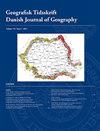A case study on the relationship between land surface temperature and land surface indices in Raipur City, India
IF 1.1
4区 社会学
Q4 ENVIRONMENTAL STUDIES
Geografisk Tidsskrift-Danish Journal of Geography
Pub Date : 2020-01-02
DOI:10.1080/00167223.2020.1752272
引用次数: 31
Abstract
ABSTRACT Land surface temperature (LST) depends primarily on the land surface material and climatic conditions. The present study focuses on deriving the LST of Raipur City and generating the relationship between LST and some land surface indices, like NDVI, NDWI, NDBI, NMDI, and NDBaI for better land-use planning and environmental management inside the city. These land surface indices respond in different ways with the changes of LST in an urban landscape. There are only a few numbers of research works available on the relationship of LST and land surface indices in a tropical city for pre-monsoon season. The present study has been performed on a total of fifteen multi-date Landsat data sets of the pre-monsoon season from 2002, 2006, 2010, 2014, and 2018. The mono-window algorithm has been applied in retrieving the LST. Results show that LST builds a positive relation with NDBI, NDBaI, and NDWI and a negative relation with NDVI and NMDI. These relationships are stronger in the area below mean LST (low LST zones) and weaker in the area above mean LST (high LST zones). It indicates that the values of LST are largely influenced by the different land surfaces, like vegetation, water, soil, and built-up area.以印度赖布尔市地表温度与地表指数关系为例
地表温度(LST)主要取决于地表物质和气候条件。本研究的重点是推导赖布尔市的地表温度,并得到地表温度与NDVI、NDWI、NDBI、NMDI、NDBaI等地表指数之间的关系,以便更好地进行城市土地利用规划和环境管理。这些地表指数对城市地表温度的变化有不同的响应方式。关于热带城市季风前季节地表温度与地表指数关系的研究文献很少。本研究对2002年、2006年、2010年、2014年和2018年季风前季节的15个多日期Landsat数据集进行了研究。在LST检索中应用了单窗算法。结果表明,地表温度与NDBI、NDBaI、NDWI呈显著正相关,与NDVI、NMDI呈显著负相关。这些关系在平均地表温度以下的区域(低地表温度区)较强,在平均地表温度以上的区域(高地表温度区)较弱。这表明地表温度的值在很大程度上受不同地表的影响,如植被、水、土壤和建成区。
本文章由计算机程序翻译,如有差异,请以英文原文为准。
求助全文
约1分钟内获得全文
求助全文
来源期刊
CiteScore
5.20
自引率
0.00%
发文量
5
期刊介绍:
DJG is an interdisciplinary, international journal that publishes peer reviewed research articles on all aspects of geography. Coverage includes such topics as human geography, physical geography, human-environment interactions, Earth Observation, and Geographical Information Science. DJG also welcomes articles which address geographical perspectives of e.g. environmental studies, development studies, planning, landscape ecology and sustainability science. In addition to full-length papers, DJG publishes research notes. The journal has two annual issues. Authors from all parts of the world working within geography or related fields are invited to publish their research in the journal.

 求助内容:
求助内容: 应助结果提醒方式:
应助结果提醒方式:


